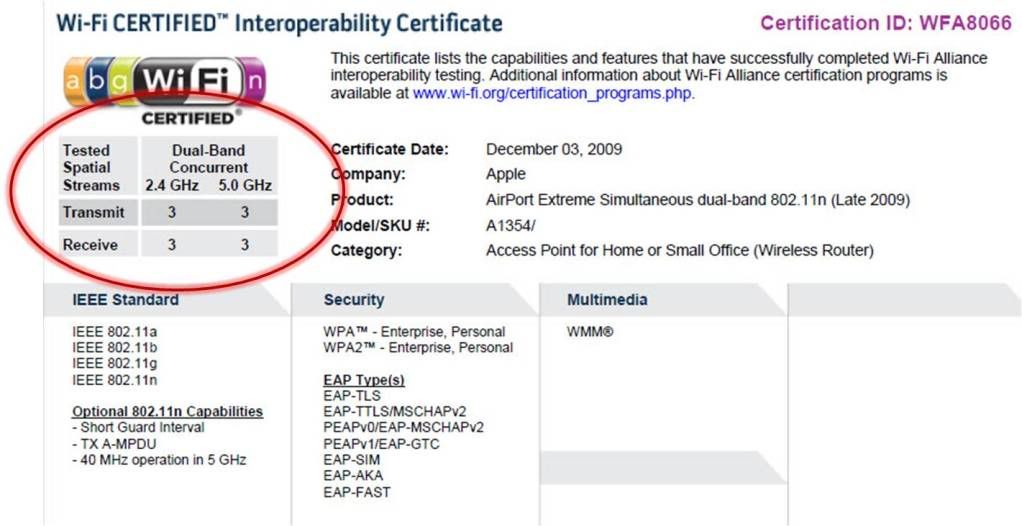First Certification: 3x3:3
By CWNP On 12/10/2009 - 29 Comments
By now, you’re likely well informed about the 802.11n-associated lingo related to MIMO, but if you’re not, here’s a quick tutorial before I get to the point of the article. When referring to 802.11n devices, companies often use an abbreviation that looks something like this: 2x2, 2x3, or 3x3 (pronounced 2-by-2, etc.). These numbers refer to the number of transmit (Tx) and receive (Rx) radio chains, respectively, that are part of the MIMO hardware design. The first number (the ‘2’ in 2x3, for example) is the number of transmit chains. The second number (the ‘3’ in 2x3, for example), as you’ve probably already deduced, is the number of receive radio chains. If you remember from 802.11a/b/g SISO systems, there is only one transceiver with one transmit and receive radio.
The point of all this is that MIMO technology can receive and transmit on multiple radio chains simultaneously. So, the supported features of a chipset are dependent upon the number of radio chains, both receive and transmit. Some 802.11n features are transmit-only features (transmit beamforming), some are receive-only features (MRC), and some are both (STBC). For example, MRC (Maximal Ratio Combining) uses multiple received signals (via separate radio chains) and combines them to maximize the fidelity of the original signal. So, MRC is a receive technology and requires 3 Rx radio chains (that’s Nx3). A feature like spatial multiplexing, which divides an original data stream into multiple data streams, requires an equivalent number of radio chains as supported data streams. So, if you’d like to support 2 simultaneous multiplexed data streams, you must have at least 2x2. It is also possible for a device to be able to receive more data streams than it can transmit, as with a 2x3, which could receive 3 data streams, but only transmit 2. If you’re with me up to this point, you also probably understand that more simultaneous data streams means more efficient use of the medium and thus, higher throughput. More is better.
Now you must be wondering why, after that crash course, the title says 3x3:3, instead of just 3x3. Well, just as the presence of 3 antennas doesn’t necessarily mean 3x3, so 3x3 doesn’t necessarily indicate support for all of the features that use 3 Tx RF chains, such as spatial multiplexing with 3 concurrent data streams or possibly transmit beamforming—which can also be done with 2 Tx chains. So, the colon (:) after the ‘3x3’ is present to indicate the number of supported transmit and receive spatial streams. So, you couldn’t have a 2:3:3, but you could have a 3x3:3, or quite possibly, a 3x3:2.
It felt like that tutorial went on and on, so let me get to the point. I read the other day about the first 3x3:3 AP to market. And the winner is: not an Enterprise WLAN solution. Apple, in fact, is the first to come out with a Wi-Fi Certified 3x3:3 AP. The Wi-Fi Alliance organizes their certified APs into two categories: SOHO and Enterprise, of which the AirPort Extreme fits into the former. Here's the certificate as proof.

While 3x3 chipsets have been shipping from manufacturers for a few years now and are already implemented in many APs, the AirPort Extreme is the first certified evidence of 3 spatial streams in an AP. Actually, it’s the first certified evidence that I’ve seen for any Wi-Fi radio, including clients. Intel’s 5300-series adapter is purported to support 3 spatial streams, but I have neither seen it in action (no APs for testing, until now) nor seen certified evidence from the Wi-Fi Alliance. I hadn’t heard of any other 3x3:3 devices, so I searched through the Wi-Fi Alliance’s certifications for confirmation.
As is usually the case, other AP vendors aren't far behind with 3x3:3s, but the client horizon is slightly less sure. Client vendors are notoriously slow at implementing features unless money is nigh or SOHO consumers are asking for it—these two criteria usually go hand in hand. However, high-speed Wi-Fi markets well, so I imagine this is a feature that won’t receive the same cold shoulder as others, like fast secure roaming.
If you’re interested in a little more education and an up-close look at radio hardware, have a look here. Tim’s article may help to provide a visual reference to pair with this MIMO article. Tim Higgins gives us a good look at the components used in the Apple AP and points out an assembly mistake that belongs under an ornate rug.
I know Apple is a major leader in SOHO mobility, but does it surprise anyone else that this feature is in the home before the enterprise? On second thought, I guess that is the trend with Wi-Fi. Home users demand high-performance Wi-Fi at work just as at home, not the other way around. 450 Mbps is at hand and I suspect that 600 Mbps is not far behind.
Blog Disclaimer: The opinions expressed within these blog posts are solely the author’s and do not reflect the opinions and beliefs of the Certitrek, CWNP or its affiliates.




0 Responses to First Certification: 3x3:3
Subscribe by EmailThere are no comments yet.
<< prev - comments page 1 of 1 - next >>
Leave a Reply
Please login or sign-up to add your comment.